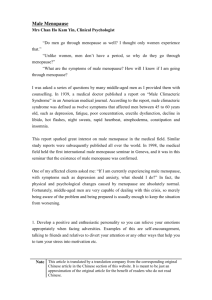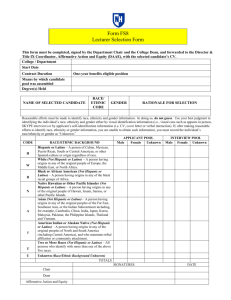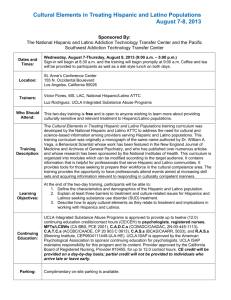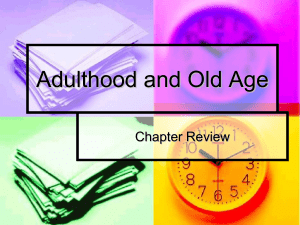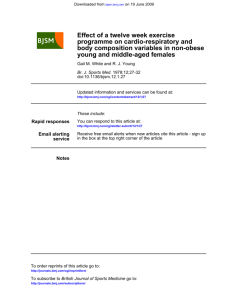assignment2-revised
advertisement
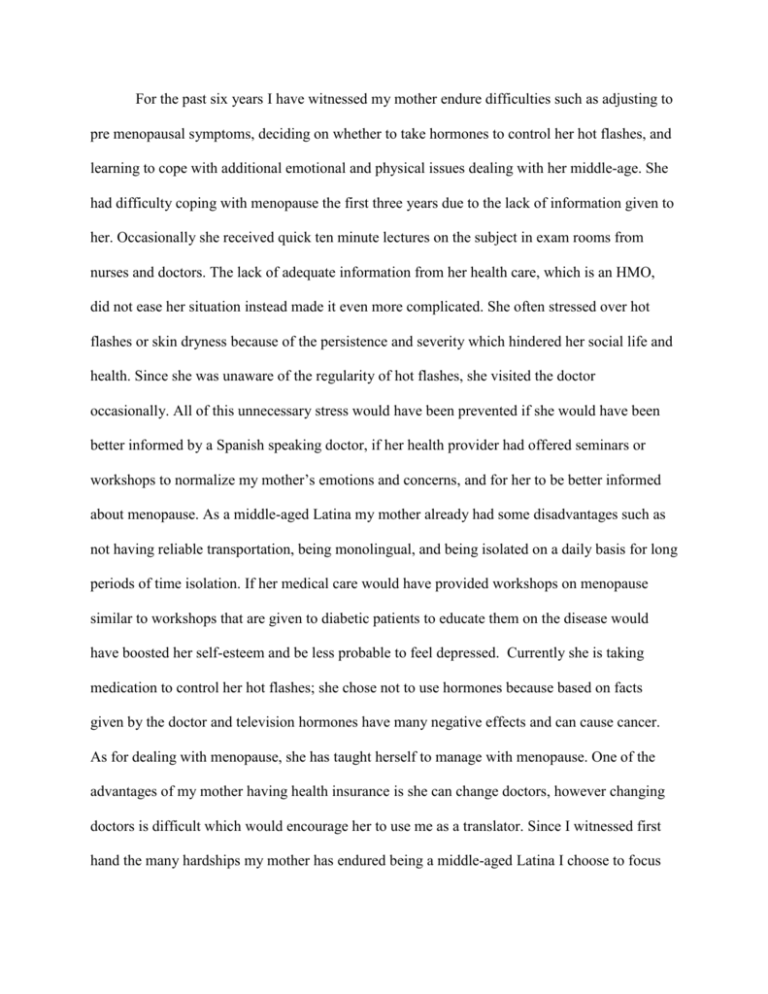
For the past six years I have witnessed my mother endure difficulties such as adjusting to pre menopausal symptoms, deciding on whether to take hormones to control her hot flashes, and learning to cope with additional emotional and physical issues dealing with her middle-age. She had difficulty coping with menopause the first three years due to the lack of information given to her. Occasionally she received quick ten minute lectures on the subject in exam rooms from nurses and doctors. The lack of adequate information from her health care, which is an HMO, did not ease her situation instead made it even more complicated. She often stressed over hot flashes or skin dryness because of the persistence and severity which hindered her social life and health. Since she was unaware of the regularity of hot flashes, she visited the doctor occasionally. All of this unnecessary stress would have been prevented if she would have been better informed by a Spanish speaking doctor, if her health provider had offered seminars or workshops to normalize my mother’s emotions and concerns, and for her to be better informed about menopause. As a middle-aged Latina my mother already had some disadvantages such as not having reliable transportation, being monolingual, and being isolated on a daily basis for long periods of time isolation. If her medical care would have provided workshops on menopause similar to workshops that are given to diabetic patients to educate them on the disease would have boosted her self-esteem and be less probable to feel depressed. Currently she is taking medication to control her hot flashes; she chose not to use hormones because based on facts given by the doctor and television hormones have many negative effects and can cause cancer. As for dealing with menopause, she has taught herself to manage with menopause. One of the advantages of my mother having health insurance is she can change doctors, however changing doctors is difficult which would encourage her to use me as a translator. Since I witnessed first hand the many hardships my mother has endured being a middle-aged Latina I choose to focus on this topic. In this research I wanted to find out what are the disadvantages for other middleaged Latinas and how are they handled by their health care. Before I continue on I want to clarify the terminology used to identify Spanish-speaking women. In article Gilliss’s 2005 the female participants self-identified as Latina, which refers to woman of Latin-America or Spanish speaking descent. In article Chang’s 2004 the women selfidentified as Latino American which refers to an American citizen or resident of Latin-American or Spanish speaking descent. In article Avis 2001 the women self described their primary racial or ethnic group as Hispanic which refers to someone from Spain or Spanish-speaking Latin America. For -the purpose of this paper I will address Latinas accordingly to the self-identity them gave themselves in each article, also each study was conducted in English and Spanish. Article Avis 2001 focuses on finding common menopausal status and symptoms among different racial/ethnic groups. My primary focus is on the Hispanic outcomes. Although the study divided the women into different menopausal statuses such as surgical menopause, combination of early and late preimenopausal, and premenopausal: I focused on the overall total of the Hispanic group as a whole rather than focusing on each menopausal status. Based on Table 1 hormone use was the lowest for Hispanic women compared to Caucasian women due to the fact that hormone use is related to race/ethnicity. It can be presumed that Hispanic women are less likely to have hormone use due to the lack of funds. Table 1 shows that out of the 1859 Hispanic female participants at least 75 percent which is more than half had somewhat or extreme difficulty paying for basics. Table 1 also states that the highest percentage of selfassessed health for Hispanic women was between fair and good (Avis 2001). How can these women have such a high percentage of good health considering that more than half have difficulty with paying for services? If a participant has difficulty paying that means they are probably in a disadvantage of receiving constant care from the same physician verses a woman who does have a health provider that allows her to keep the same doctor. A woman who has difficulty paying is more prone to struggle with establishing rapport with any particular doctor because she is often being exam by a different doctor. To make matters worse if the patient is a middle-aged Latina who is monolingual is more problematic for the physician to build rapport due to the language barrier. Article Chang 2004 discusses this dilemma that middle-aged Latino American women face when interacting with physicians. The language barrier does play a factor for middle-aged Latino American women to trust doctors. However it is not as essential as for the physician to build rapport or trust with the Latino American women through specific behaviors. Middle-aged women prefer for physicians to demonstrate their trust by being attentive, to encourage questions, ask about issues beyond presenting symptoms, and use respectful language. Other concerns that the participants mentioned in the study were the switching of doctors when the patient did not have good rapport with the doctor, however some felt limited due to the health insurances limitations and the process. Another issue that the participants raised was intimidation. Middle aged women felt embarrassed to ask the doctor because they do not know English or they do not feel comfort having a translator be aware of their health problems. The article focuses on the lack of assertiveness in Latino American middle-aged women, however their health circumstances and age should also be taken in consideration (Chang 2004). Middle-aged women experiencing menopause find it difficult to be vocal about issues that are arising due to their symptoms especially if they are in an uncomfortable medical setting. The interaction of physician and patient is relevant to the social work practice because it is critical for the social worker to build a good rapport with the client in order to better assess them. With good assessment the social worker is able to find the client’s strengths which will facilitate the process of empowerment. The behaviors that the participants describe in this study exhibit trust are similar characteristics that social workers should have in order to successfully build a good rapport with the client and encourage the client to continue attending sessions. Also the description of these characteristics should be kept in mind for future reference when dealing with middle-aged Latino American women. A similarity I found between Avis 2001 article and Gilliss 2005 which is that both articles find depression as one of the symptoms among the middle-aged Latina and Hispanic population. In article Avis 2001 depression is categorized as the third symptom; tension has the highest percentage then it is followed by headache. But unlike the Avis 2001 article, Gilliss 2005 does encourage further intervention of health care professionals to better assess a female’s physical activity, body weight and depressive symptoms. For middle-aged Latina, Hispanic, Latino American it promotes more physical activity and improvement in a women’s mental health. This issue is not even mentioned in Avis 2001 article. The call for intervention of health care professionals should be made for the participants in Gilliss 2005 article. Neither article mentions how informed participants are on menopause and its’ effects which is an important matter to consider. The disadvantage these participants have is the lack of intervention which could help support their mental and physical health. This intervention is relevant to the social work field because social workers need to consider the mental and physical symptoms that middle-aged Latinas, Hispanics and Latino American women endure. It would be nice for social works to find intervention services for middle-aged Spanish speaking women. The interventions would be positive experience for the women which can boost their self esteem and empower them. Low-income middle-aged Latinas, Hispanics, and Latino American are in need of these interventions the most which would allow for them to normalize their particular situation. In the social work field client’s health is a main concern because without the client being in good health he/she can not perform to their maximum and allow focusing on their strengths. In conclusion the research found that other middle-aged Latina, Hispanic, and Latino American women had the similar disadvantages that my mother had. The participants endure the language barrier with physicians, depression, and the lack of intervention services that can improve their mental and physical health. Although the articles do not go into depth about the health care services they receive we were given information in which we presumed that health care services did not provide the participants with enough help such as interventions that would ease and normalize some of the women’s concerns. Based on the data given in the tables one can suggest that the majority of the women in the three articles are either low-income or middle-class which means that both classes struggle financially. The access for good health care is not guaranteed. The implications of social work found in the articles is the importance of social workers to use the guidelines that middle-aged women described in the Chang 2004 article to build a good rapport with future clients from the same population. The second implication is the need for social worker to advocate for intervention services for middle-aged clients that will improve their mental and physical health. This would empower the client to be more educated on the subject, its’ symptoms, and will have a support system rather than having to resort to other non medical resources. Bibliography Avis, N. E., Bromberger, J., Cain, V., Crawford, S., Ganz, P., Kagawa-Singer, M., & Stellato, R. (2001). Is there a menopausal syndrome? Menopausal status and symptoms across racial/ethnic groups. Social Science and Medicine, 52. 345-356. Chang, G., Reynoso, H., & Weitzman, P.F. (2004). Middle-aged and older Latino American women in the patient-doctor interaction. Journal of Cross-Cultural Gerontology, 19. 221-239. Gilliss, C., Guiterrez, Y., Juarbe, T.C., & Lee, K.A. (2005). Depressive symptoms, physical activity, and weight gain in premenopausal Latina and White women. Maturitas, 55 (2). 116-125. Guidelines for paper: Chose a narrow topic Find three recent journals from three different journals in the library that deal with your topic. Write a short (up to 5 pages typed and double-spaced) paper that integrates the content of the three articles. In order to be integrative, the paper must do something with the content of the articles. For example, you should develop a theme which will follow throughout your paper. In doing so, you might compare and contrast the different points of view presented in the articles, discuss the implications of social work practice, etc. Do not merely summarize each article in succession. Document your paper in APA style and include a reference list.


